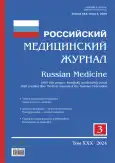Medico-demographic and medico-social determinants of the birth rate of the population in the Chechen Republic
- Authors: Shapovalova M.A.1, Ezhaev A.V.1, Yaroslavtsev A.S.1, Perepechkin A.N.1, Abramova D.A.1, Abdullaeva A.S.1, Saprykin G.A.1
-
Affiliations:
- Astrakhan State Medical University of the Ministry
- Issue: Vol 30, No 3 (2024)
- Pages: 208-217
- Section: Original Research Articles
- URL: https://journals.rcsi.science/0869-2106/article/view/262445
- DOI: https://doi.org/10.17816/medjrf582449
- ID: 262445
Cite item
Abstract
BACKGROUND: Over the years, the birth rate in Russia has decreased due to a transformation in the family structure, a change in attitudes toward marriage and family, and economic and social reasons. The ratio of fertility and mortality determines the population reproduction regime, changing economic development and national security conditions. The analysis and assessment of the birth rate in the Chechen Republic is crucial because the results can be used to formulate a system of demographic policy measures considering national traditions of matrimonial behavior.
AIM: To develop recommendations for increasing the birth rate of the population in the Chechen Republic as a territory with strong traditions of the priority of family values.
MATERIALS AND METHODS: The study was conducted based on official statistics of the Chechen Republic for 2010–2021 and a sociological survey of mothers.
RESULTS: Medical and demographic processes in the territory of the Chechen Republic had a general unfavorable trend in the 12-year period from 2010 to 2021. The only positive aspect that can be considered is a threefold decrease in the birth rate in the same period among mothers aged >40 years, as older mothers carry a large burden of chronic pathology, causing a risk to the health of newborns.
CONCLUSION: Negative stable trends in age-specific decline in fertility in the reproductive period among women in the Chechen Republic indicated the unfavorable demographic situation in Russia, despite the priority of family values and stable traditions of large families. The reserves for improving the demographic situation in the region are hidden in the need for systematic information support for families to use their rights to state benefits aimed at protecting motherhood and childhood, monitoring and evaluating the effectiveness of these measures.
Full Text
##article.viewOnOriginalSite##About the authors
Marina A. Shapovalova
Astrakhan State Medical University of the Ministry
Email: mshap67@gmail.com
ORCID iD: 0000-0002-2559-4648
SPIN-code: 9989-3343
MD, Dr. Sci. (Medicine), professor
Russian Federation, AstrakhanAkhmed V. Ezhaev
Astrakhan State Medical University of the Ministry
Email: bekhan001@gmail.com
ORCID iD: 0000-0001-9355-2928
Russian Federation, Astrakhan
Alexander S. Yaroslavtsev
Astrakhan State Medical University of the Ministry
Email: yarastr@mail.ru
SPIN-code: 2077-9472
MD, Dr. Sci. (Medicine), associate professor
Russian Federation, AstrakhanAlexander N. Perepechkin
Astrakhan State Medical University of the Ministry
Email: perep1965@gmail.com
SPIN-code: 5392-6944
MD, Cand. Sci. (Medicine), associate professor
Russian Federation, AstrakhanDaria A. Abramova
Astrakhan State Medical University of the Ministry
Email: dariashap96@gmail.com
ORCID iD: 0000-0002-6023-4824
Russian Federation, Astrakhan
Aliya S. Abdullaeva
Astrakhan State Medical University of the Ministry
Author for correspondence.
Email: alya_kubekova@mail.ru
ORCID iD: 0000-0002-6534-7035
SPIN-code: 6682-3573
Cand. Sci. (Psychology), associate professor
Russian Federation, AstrakhanGleb A. Saprykin
Astrakhan State Medical University of the Ministry
Email: saprykin.org@mail.ru
Russian Federation, Astrakhan
References
- Polunina NV, Polunin VS. Contribution of the Departments of Public Health and Public Health to the health saving of the Russian population. In: Zdorovesberezberezhenie: best practices and prospects: collection of materials of the III Regional Scientific and Practical Conference of Young Scientists and Students. Volgograd: Volgograd State Medical University, 2023. P. 5–7. (In Russ). EDN: NHNKFT
- Zakorkina N. Medico-demographic issues related to reproductive potential of the Omsk region population in 2007–2017. 2019;65(5):8. Social Aspects of Population Health. EDN: UAQPUB doi: 10.21045/2071-5021-2019-65-5-8
- Konovalov OE, Linnichenko YuV. Medical and demographic characteristics of the population of the Moscow Region. Tverskoj medicinskij zhurnal. 2020;(2):191–195. EDN: TGWWXT
- Luneva IS, Ivanova OJu, Khardikov AV, et al. Demographic indicators of fertility and medical and social influence on them. Journal of Obstetrics and Womens Diseases. 2017;66(2):40–48. EDN: YNBWBX doi: 10.17816/JOWD66240-48
- Sakhbetdinova KI. Determinants of fertility in Russian families // Moscow University Economics Bulletin. 2020;(6):104–123. EDN: RIRRKV doi:
- Cherkasov SN, Kurnosikov MS, Sopova IL. Use of demographic analysis in planning the volume of medical care. In: Petrov PG, editor. Ecology and human health in the North. Сollection of scientific papers of the VIth Congress with international participation. 2016. P. 601–605. EDN: VNFGLX
- Shapovalova MA, Boyko YuP, Putin ME, et al. Ways to increase the effectiveness of medical care for children suffering from diseases of the musculoskeletal system diseases. Medicinskij vestnik MVD. 2021;(1):24–28. EDN: QKAHKT
- Chernysheva NV, Molochnyy VP. Medical and demographic indicators of the population of the Khabarovsk Territory in 2009–2020. Dal’nevostochnyj medicinskij zhurnal. 2022;(2):57–62. EDN: VBIWLM doi: 10.35177/1994-5191-2022-2-10
- Melnikova EA, Kurbat YL. Assessment of demographic problems of population fertility at the regional level. Alleja nauki. 2018;3(4): 380–384. EDN: XOYABF
- Topalov KP, Lobastova OV, Prisyajnyuk IK. Medical and demographic aspects of reproduction of the population of the Khabarovsk Territory at the turn of the XX–XXI centuries. Zdravoohranenie Dal’nego Vostoka. 2019;(4):5–12. EDN: SSQGUS doi: 10.33454/1728-1261-2019-4-5-12
- Khodakova OV, Koshevaya NV. The medical demographic characteristics of health status of population of the Trans-Baikal Krai. Problems of Social Hygiene, Public Health and History of Medicine. 2019;27(6):1027–1031. EDN: OPQJBQ doi: 10.32687/0869-866X-2019-27-6-1027-1031
Supplementary files
















